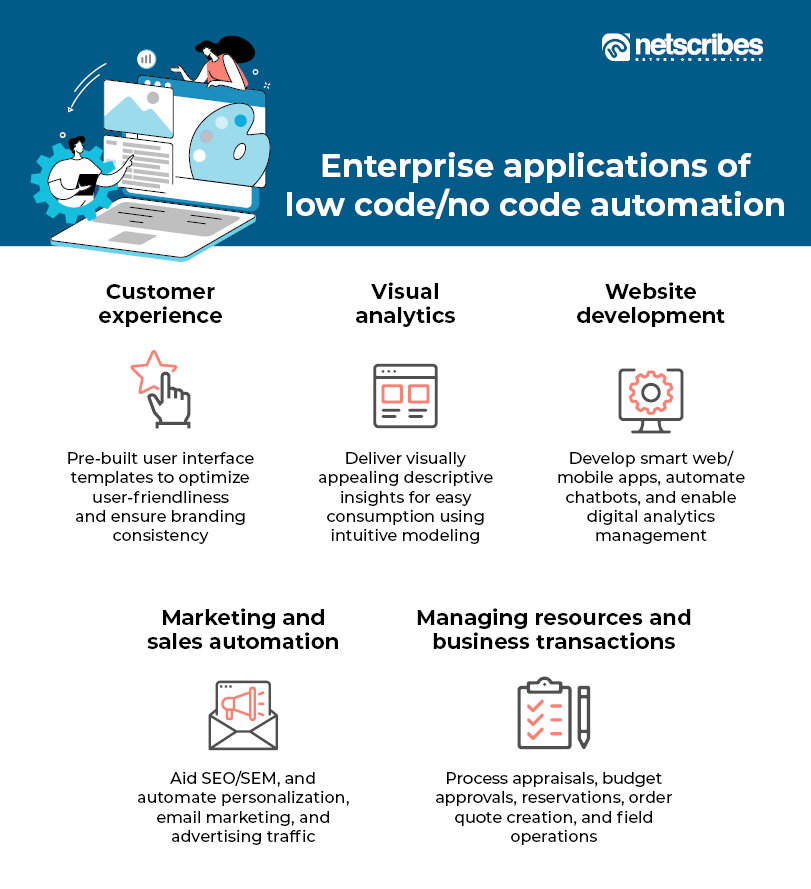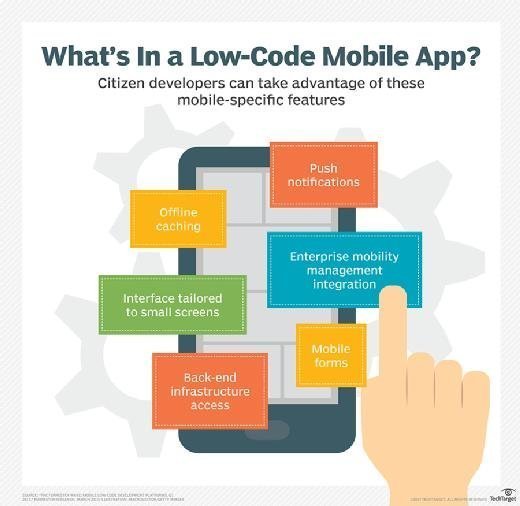New Tips For Selecting Low-Code Platform Info
New Tips For Selecting Low-Code Platform Info
Blog Article
Benefits Of Low-Code Application Development In Terms Of Speed
Visual Development Environment (VDE):
Drag-and-Drop Interfaces: Low-code platforms provide visual tools for designing applications. Drag-and-drop tools allow developers to build apps quickly without having to write code.
Templates and pre-built components: Many low code platforms come with pre-built components as well as templates, which allow developers to quickly build prototypes and develop applications.
Reduced Coding requirements:
Automated Code Generating: Low-code platform automatically generates code beneath based on visual models that developers create. This reduces the requirement to code manually and speeds up development.
Reusable component: Developers are able to make use of the same components in different projects. This reduces time spent on developing code and testing.
Collaboration can be made easier.
Integration of Development Tools: Low-code tools often include tools for version control as well as testing and deployment which facilitates seamless collaboration between development teams.
Citizen Development: Business users as well as non-developers are able to contribute to the development of applications using simple interfaces, reducing the bottleneck that is often caused by the limited access to professional developers.
Rapid Iteration and Prototyping:
Rapid prototyping: Designers are able to quickly create prototypes to collect feedback and verify ideas, which results in quicker cycles of iteration.
Simple Modifications - The visually appealing nature of low-code applications allows easy updates and changes that speed the process of refining applications based on user feedback.
Pre-built Integrations:
API Integrations. Low-code platforms usually have pre-built connectors and APIs for popular services that reduce the amount of time required to integrate with other systems.
Data Integration: The built-in tools facilitate the process of connecting to databases and other sources, speeding up development.
Scaling deployment:
Many low-code platforms have the option of deploying applications with one click, which reduces the amount of time and effort required to install applications.
Cloud-based Solutions: Cloud platforms with low-code let developers focus on the design and function of their apps instead of worrying about the logistics of deployment.
Overall, low-code development has advantages in terms of speed due to its ability of automating and simplifying many aspects of development. This allows for faster development of apps as well as easier adapting to the changing demands. See the recommended Low-code Platform for application development for blog examples including application development platforms, app platforms, software for app development, application modernization software, cross platform app dev, no code platforms, azure sql databases, rapid applications, build with docker, mobile development platforms and more.
Low-Code Apps Have Numerous Advantages In Terms Of Cost-Effectiveness.
Low-code app development offers a number of benefits, including cost efficiency. It is a popular choice for companies who wish to maximize their development budgets without compromising on quality. Here are some of the major advantages:
Reduced Coding: Low-code platforms reduce the amount of manual coding needed which reduces the time and energy spent by developers in the process of creating applications. It also means lower labor cost.
Reduced Developer Resources: Since low-code is more efficient and less time to create, less skilled developers will be required. This reduces the need for cost of hiring and staffing.
More Time to Market
Rapid development cycle Visual development tools as well as pre-built components provided by platforms that use low-code allow rapid design of applications, which allows companies to deliver products to market more quickly. This can result faster revenue generation, and improved positioning in the market.
Rapid Prototyping. Through the rapid creation and testing prototypes companies can cut down on time spent development and improve their product faster based on feedback from users.
Lower cost of maintenance:
The modular design and standard components of apps developed using low-code platforms make them easy to maintain. It reduces maintenance and support costs.
Automated Updates: A lot of low-code platforms handle patches and updates in a way that is automatic and ensure that applications are secure and up-to-date without requiring extensive manual intervention.
Efficient Resource Utilization:
Low-code platforms enable people who are not developers to take part in the development process. This allows companies to use the skills of their employees and decrease their dependency on highly-paid programmers.
Improved Utilization Of IT Resources IT teams can focus on strategic initiatives rather than being stymied by routine development work, improving productivity and overall efficiency.
Pricing models that can be scaled:
Subscription pricing: A lot of low-code platforms offer different subscription pricing options that increase with use. This gives businesses the capability to adapt their spending according to their needs and growth without having to pay large upfront costs.
Pay-Assosiated Option: A few platform providers offer pay-assosiated options. These options ensure that companies pay only for the resources used and are beneficial for small and new businesses that have limited resources.
Costs for reduced Third-Party Software:
Built-in Functionalities: Low-code systems often come with built-in functionalities and integrations that minimize the need for additional third-party software and tools, resulting in cost savings on licensing fees and subscription costs.
Pre-Built Integrations: By integrating popular services and systems it can save you time and money by avoiding the need to develop custom integrations.
Increased ROI
Faster Return on Invest: Combining rapid development with less expense and a shorter time to market, businesses will see a greater return on their investment (ROI).
Enhanced agility. Businesses are able to quickly adjust to market changes and customer requirements, ensuring they remain relevant. They also can profit from new business opportunities as they come up.
Costs of training are lower:
User-Friendly Interfaces: The nimble user-friendly interfaces offered by low-code platforms cut down on the learning curve of new users, eliminating the need for lengthy training programs.
Accessible Resources. Many low-code platforms provide complete training materials including tutorials, training, and community assistance. They make it less necessary to undergo formal training, which can be expensive.
Collaboration can be made easier.
Improved Collaboration Tools: The integration of collaboration tools allows better collaboration between team members, as well as an improvement in overhead for projects.
Unified Development Environment : A unified environment simplifies work flows and lowers the cost of managing multiple tools and platforms.
In general, low-code apps cost less due to their ability to lower costs of development and maintenance and to speed up time-to-market to maximize resource use and also to offer an affordable pricing. These factors combine to deliver substantial financial benefits to businesses and make low-code development a viable choice for organizations aiming to increase their budgets for development while also delivering solid, scalable and top-quality applications. Check out the best Enterprise application development with Low-code Platform hints for site info including app platforms, azure sql server, push notifications, low code development platforms, app dev platform, develop web app, cross platform mobile development, cross platform mobile app development, stored sql procedures, software for app development and more.
Low-Code Apps Have Many Advantages In Terms Collaboration And Workflow
Low-code development offers many benefits for collaboration and workflow. This is why it is a perfect solution for businesses seeking to increase productivity and speed up the process of development. These are the main advantages: Improved Cross-Functional Collaboration:
Unified Development Environment : Low-code platforms offer a unified, single environment in which all team members are able to work effectively such as business analysts, designers and other stakeholders. This reduces the number of silos and enhances communication.
Visual Development Tools - The drag-and drop visual nature of low code platforms allows people who are not technical to take part in the development process. This helps ensure that the requirements of business are accurately analyzed and implemented.
Communication Enhancement
Real-Time Co-operation: Many platforms that use low-code support real-time collaboration features such as commenting, editing simultaneously and getting instant feedback. They facilitate continuous communication by reducing the time needed for back-and-forth discussion.
Shared Workspaces: Teams are able to work together in shared workspaces, which allows them to view, edit and discuss project components, ensuring everyone is on the same page and working towards the same goals.
A streamlined workflow management system:
Built-in Project Management Tools : Low-code platforms typically include integrated project management software that helps teams plan, track, organize, and manage their projects for development. This includes the management of tasks, tracking progress and management of deadlines.
Workflow Automation Automating repetitive tasks and workflows can help reduce manual errors and efforts and allow the team to concentrate on the strategic tasks while increasing efficiency.
Speedier Iteration Cycles:
Rapid Prototyping Low-Code platforms are great for speedy prototyping. Iterative development is also feasible and allows teams to develop, test and refine their applications within shorter time. This allows for quick feedback and further improvement.
Agile Development Support : Support of agile practices lets team members develop sprints. They can continuously deliver small improvements in functionality and more easily adapt to changing requirements.
Accessibility for non-developers:
Citizen Development - Low-code platforms allow business users the capability to create and modify apps without coding expertise. This frees IT and Development teams of the burden and allows faster responses to business requirements.
Training and Onboarding Intuitive interfaces and extensive training materials make it simpler for new team members to get up to speed, enhancing the overall collaboration within the team.
Centralized documentation and knowledge sharing
Low-code platforms typically include features for creating, maintaining and storing documents within their platform. This allows the entire project's information to be stored in a central location and easily accessed.
Knowledge Repositories: Teams are able to develop and maintain knowledge repositories that contain best practices, templates and reusable components, which aid in sharing of knowledge and reducing the repetition of efforts.
Consistency and Standardization:
Standardized components: Standardized components that are pre-built ensure consistency in the applications. Team members can comprehend and work with greater ease on various parts.
Governance and Compliance: The built-in governance frameworks ensure that all development adheres to organizational standards and regulatory requirements, reducing the possibility of non-compliance as well as ensuring that applications meet quality standards.
Feedback and Improvement
Integrated Feedback mechanisms: Platforms with low-code typically have a built-in feedback mechanism, which allows users to easily give feedback on the application. Feedback can then become integrated into the development.
Continuous Improvement: The capacity for applications to iterate quickly and implement changes based off of feedback, while ensuring they are in line to the needs of the user and business goals.
Visualization and Reporting:
Real-time Analytics: Built-in analysis and reporting provides real-time information about project performance, user interactions and the progress. Data-driven decision-making is feasible.
Visual Workflow Maps: Tools for mapping processes or workflows can be useful for teams to understand their processes. They can also identify the bottlenecks that are present, as well as areas that need improvement.
Low-code development offers many benefits in terms of workflow and collaboration. It can bring diverse teams together, improve processes, streamline communication, and boost teamwork. This results in a more cooperative and efficient development environment, ultimately leading to higher-quality applications and better alignment with business objectives.